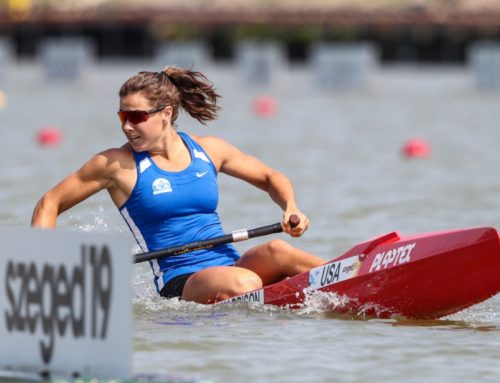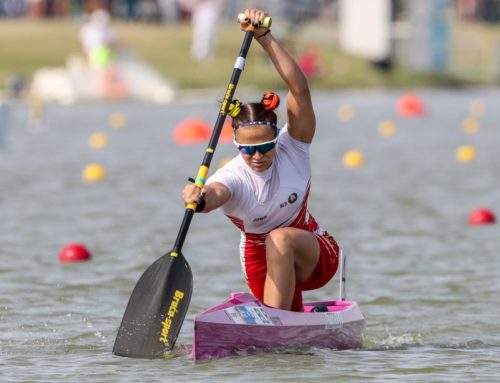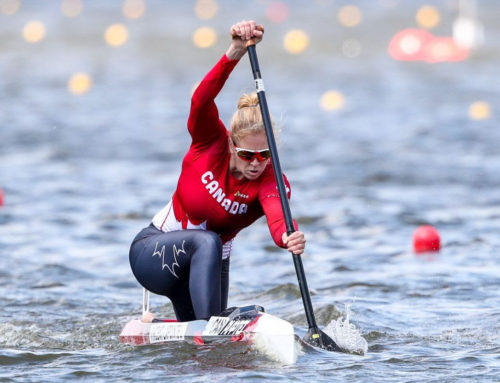Photo credit: Washington Canoe Club. Photo enhancement courtesy of William Scott Miller.
One of the many myths surrounding women’s participation in Olympic canoeing – or Canadian canoeing – is that our participation is a recent phenomenon. “Recent”, as in the last 5, 10, even 20 years. Here are a few facts and the first of many stories from our wonderful history.
Paddling in canoes has been a method of transportation, a means of gathering food, recreational outlet, and a part of survival for women and their families for centuries. Our Aboriginal, First Nation, Asian, African, Central/South American and Polynesian sisters and ancestors are great examples of this. We have documentation of women paddling canoes Canadian-style (i.e., “high kneel”) dating back to 1918 (Washington Canoe Club, Washington DC, USA) and even 1914 in War Canoes (Carleton Place Canoe Club, Ontario, Canada). The first documented Canadian Women’s War Canoe race was 1923. Currently, any of the four age categories of War Canoe at Canadian National Championships can have nearly 130 women competing for a high intensity, high kneel race and it has been this way for over half a century.
Here is a snapshot of Elizabeth Smith, USA, and some historical context. We are furthering our research to learn more about her.
From 1918 – 1921, Miss Elizabeth Smith and Harry T. Knight, Jr., were Mixed Tandem (C2) Champions at the Washington Canoe Club in Washington, DC, USA.
Harry Knight competed for the Washington Canoe Club in the 1924 Olympics “Demonstration” events against the Canadian Canoe Association (now Canoe Kayak Canada). Harry competed in the kayak (double blade) and canoe (single blade) events.
Elizabeth Smith stayed home.
BACKGROUND
“Canoeing” was a Demonstration sport at the 1924 Summer Olympics in Paris. It was the first time that the sport was part of the Olympic program. Canoeing became a full medal sport 12 years later at the 1936 Games in Berlin.
The French Olympic Committee, as hosts of the Games, asked the Canadian Olympic Committee to demonstrate the sport in Paris. Races were arranged between the Canadian Canoe Association (now CKC) and the Washington Canoe Club from the United States. Events were held for each of 1, 2, and 4 person boats for both single-blade paddles (modern canoe style) and double-blade paddles (modern kayak style).
Reference
From an International Canoe Federation document:
“DEMONSTRATIONS OF SPORTS OUTSIDE OLYMPICS PROGRAM
Article VI of the General Rules of the Olympics, adopted by the 1921 IOC Congress in Lausanne, stipulated that the Games Organizing Committee will provide demonstrations of two sports not included in the program:
1. A national sport;
2. A sport foreign to the host country.
Therefore, under the General Rules and the desire expressed by the IOC, the Executive Committee decided to organize:
1. A demonstration of Basque Pelota as the French national sport;
2. A demonstration of Canadian Canoe as a national sport of a foreign country;
3. A demonstration of the Games of Childhood (including Volleyball).
A little later, a demonstration of Savate (French Boxing) and la Canne (Cannes), eminently French sports, was added to the demonstration of Basque Pelota as a national sport.”
100 years later, we are ecstatic to report that the International Olympic Committee anounced the inclusion of 3 women’s canoe events for the Tokyo 2020 Olympic Games in a press release June 9, 2017.
Elizabeth’s Sisters of the Single Blade will FINALLY get to shine!
See ICF Press Release; IOC Press Release;




Leave A Comment